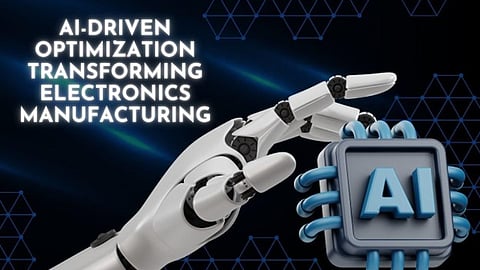

In this modern era Artificial intelligence is revolutionizing the electronics manufacturing industry by optimizing processes, enhancing quality control, and improving supply chain efficiency. Gautam Nandkishore Nayak, an expert in AI-driven manufacturing strategies, explores how machine learning models and automation are shaping the next generation of smart manufacturing systems. His research highlights the role of AI in refining production efficiency while reducing costs and defects.
The integration of AI in manufacturing has transformed traditional production methods, enabling real-time decision-making and predictive analytics. AI-driven systems analyze vast datasets, continuously monitoring and adjusting process parameters. This results in improved first-pass yield (FPY), higher production throughput, and minimized defects. Facilities implementing AI-based automation have reported efficiency gains of up to 35%, making real-time adjustments to maintain seamless production. AI also enables manufacturers to detect inefficiencies at early stages, preventing costly errors and ensuring smoother workflow execution across production lines.
Predictive AI models have redefined supply chain management by improving material sourcing and inventory control. By leveraging real-time market insights, manufacturers have reduced material costs by 18.7% and enhanced supplier reliability by 34.2%. Smart sourcing algorithms enable organizations to optimize procurement, cutting component lead times by 29.4% and refining supplier quality.
Additionally, AI-driven logistics systems optimize delivery schedules, reducing inventory bottlenecks and preventing stock shortages. Companies implementing AI-driven supply chain solutions have improved their order fulfillment rates to 99.5%, ensuring product availability without excess storage costs. AI systems also monitor supplier performance, allowing businesses to anticipate delays and adjust sourcing strategies proactively, ensuring stable production cycles.AI also enables manufacturers to efficiently sell excess electronic components by identifying surplus inventory and connecting with potential buyers in real time, reducing waste and maximizing profitability.
AI-powered quality inspection systems have set new benchmarks in defect detection. These advanced systems achieve a 99.97% accuracy rate, surpassing conventional inspection methods. By using deep learning and computer vision, manufacturers have reported a 67.5% decrease in customer returns and a 78.3% drop in warranty claims. Unlike traditional inspection methods, AI monitors every unit in real time, leading to a 43% improvement in defect prevention and reducing rework costs. AI-powered anomaly detection ensures even minute defects are flagged before products reach customers, improving brand reputation and reliability.
AI systems continuously adjust process parameters to maintain optimal efficiency. Manufacturers leveraging digital twin technology have reduced production development time by 34.8% while cutting process variability by 62.7%. AI-powered process control minimizes downtime, extending equipment lifespan by 41% and ensuring consistent product quality. These smart systems also optimize resource allocation, ensuring that raw materials and labor are utilized efficiently without unnecessary waste.
AI’s impact on cycle time reduction has been transformative. Smart manufacturing solutions process real-time data from 2,300 sensors per production line, allowing dynamic adjustments that have led to a 41.3% reduction in cycle times. These improvements have also contributed to a 32.8% rise in overall equipment effectiveness (OEE) and a 28.4% increase in production throughput. AI-powered scheduling tools further enhance production efficiency by predicting demand fluctuations and optimizing production runs accordingly.
AI-driven predictive maintenance has significantly reduced unexpected machine failures. Manufacturing facilities implementing predictive analytics have decreased unplanned downtime by 52.3%, ensuring continuous production flow. These AI systems analyze real-time sensor data, predicting potential failures before they occur, thereby lowering maintenance costs and improving equipment utilization. This proactive approach extends machinery lifespan while reducing costly emergency repairs, ensuring smooth and uninterrupted production.
The AI-driven transformation in manufacturing is expected to continue its rapid growth. With a projected 28.5% annual increase in AI-driven manufacturing technologies, future advancements will focus on machine learning enhancements, automation, and robotics integration. Medium-sized manufacturing facilities adopting AI solutions are already reporting annual savings of $5.2 million, reinforcing the long-term benefits of AI in production. AI’s role in sustainability is also growing, as companies use AI-driven systems to reduce waste, optimize energy consumption, and minimize environmental impact.
In conclusion, AI has redefined electronics manufacturing by enhancing efficiency, reducing costs, and improving product quality. By integrating predictive analytics, real-time monitoring, and machine learning, manufacturers are optimizing every stage of production. Gautam Nandkishore Nayak’s research highlights how AI-driven smart manufacturing is setting new industry standards, ensuring a future where automation and intelligence drive operational excellence. With AI continuing to evolve, businesses that embrace this technology will remain competitive, agile, and ready for the future of manufacturing.
